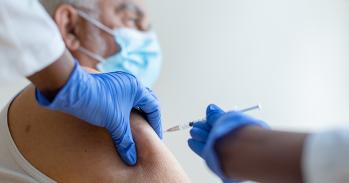
An experimental drug currently being trialled for influenza and Ebola viruses could have a new target: norovirus, often known as the winter vomiting virus. A team of researchers at the University of Cambridge has shown that the drug, favipiravir, is effective at reducing – and in some cases eliminating – norovirus infection in mice.
An experimental drug currently being trialled for influenza and Ebola viruses could have a new target: norovirus, often known as the winter vomiting virus. A team of researchers at the University of Cambridge has shown that the drug, favipiravir, is effective at reducing – and in some cases eliminating – norovirus infection in mice.
Our work in mice is very promising and shows that the drug favipiravir can make the virus mutate itself to death
Armando Arias
Norovirus is the most common cause of gastroenteritis in the UK. For most people, infection causes an unpleasant but relatively short-lived case of vomiting and diarrhoea, but chronic infection can cause major health problems for people with compromised immune systems. In many cases, patients who have weaker immune systems suffer from norovirus infection for months to years, with some patients experiencing gastroenteritis for as many as eight years. Outbreaks can cause significant economic losses – in UK hospitals alone, the cost of treating outbreaks is estimated at over £100 million a year, and foodborne outbreaks in the US lead to economic losses of around $2 billion per year.
The virus is notoriously difficult to study because it will not grow efficiently in the laboratory, therefore scientists often use a mouse norovirus to identify drugs that can inhibit infection. It is one of a class of viruses known as RNA viruses, which have ribonucleic acid (RNA) as their genetic material. Most of the major viruses that have the potential to become epidemics are of this class. RNA viruses replicate and mutate rapidly, making them challenging to develop vaccines or immunity against.
In a study published today in the journal eLife and funded by the Wellcome Trust, a team of researchers led by Professor Ian Goodfellow has shown in mice with a long-term norovirus infection that the experimental drug favipiravir is effective at lowering levels of norovirus in the body, including in both tissue and faeces, which may help in reducing the severity of the disease and onward transmission.
Favipiravir is an experiment antiviral drug which is thought to be effective against a number of RNA viruses such as influenza, West Nile virus, yellow fever virus, and foot-and-mouth disease virus. It is currently also been tested as a potential drug to treat Ebola virus. The University of Cambridge team has shown that the drug works by causing the virus to self-destruct in a process known as ‘lethal mutagenesis’, which causes errors in the virus’s genetic information; because RNA viruses replicate and mutate rapidly, the errors take hold quickly, neutralising the virus and preventing further spread. This is one of the first demonstrations of lethal mutagenesis as a method of fighting viruses in their natural hosts and suggests that it may be possible to tackle other RNA viruses in the same way.
“Norovirus is an unpleasant bug that spreads quickly,” says Professor Goodfellow, a Wellcome Trust Senior Fellow, who led the study. “Most of us will have experienced it at some point and will know that the only option is to ride out an infection, drinking plenty of fluids. But some patients get infections that can last months or years, and this has a real impact on their quality of life. The ease with which infections spread, particularly in places such as hospitals, schools and cruise ships, and the potentially serious health problems norovirus can cause people with weakened immune systems means that we desperately need a way to treat infection.”
Dr Armando Arias, first author, adds: “Our work in mice is very promising and shows that favipiravir can make the virus mutate itself to death. It suggests that as well as treating infected individuals, the drug may also be useful in preventing infection during an outbreak. The next steps will be to test whether this drug is safe and effective at treating patients, too.”
Reference
Arias, A et al. Favipiravir elicits antiviral mutagenesis during virus replication in vivo. eLife; 21 Sept 2014.
The text in this work is licensed under a Creative Commons Licence. If you use this content on your site please link back to this page. For image rights, please see the credits associated with each individual image.





